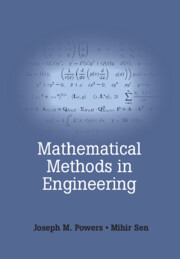3654 results in ebooks in fluid mechanics
Dedication
-
- Book:
- Successful Grant Proposals in Science, Technology, and Medicine
- Published online:
- 05 September 2015
- Print publication:
- 19 March 2015, pp v-vi
-
- Chapter
- Export citation
Preface and Acknowledgments
-
- Book:
- Successful Grant Proposals in Science, Technology, and Medicine
- Published online:
- 05 September 2015
- Print publication:
- 19 March 2015, pp ix-xii
-
- Chapter
- Export citation
1 - The Scientific Grant Proposal and Its Narrative
-
- Book:
- Successful Grant Proposals in Science, Technology, and Medicine
- Published online:
- 05 September 2015
- Print publication:
- 19 March 2015, pp 1-35
-
- Chapter
- Export citation
Contents
-
- Book:
- Successful Grant Proposals in Science, Technology, and Medicine
- Published online:
- 05 September 2015
- Print publication:
- 19 March 2015, pp vii-viii
-
- Chapter
- Export citation
2 - The Aims Section
-
- Book:
- Successful Grant Proposals in Science, Technology, and Medicine
- Published online:
- 05 September 2015
- Print publication:
- 19 March 2015, pp 36-67
-
- Chapter
- Export citation
6 - The Methods Section, Part 2
-
- Book:
- Successful Grant Proposals in Science, Technology, and Medicine
- Published online:
- 05 September 2015
- Print publication:
- 19 March 2015, pp 197-243
-
- Chapter
- Export citation
8 - Technical features of sentences
-
- Book:
- Successful Grant Proposals in Science, Technology, and Medicine
- Published online:
- 05 September 2015
- Print publication:
- 19 March 2015, pp 282-350
-
- Chapter
- Export citation
Index
-
- Book:
- Successful Grant Proposals in Science, Technology, and Medicine
- Published online:
- 05 September 2015
- Print publication:
- 19 March 2015, pp 360-378
-
- Chapter
- Export citation
Frontmatter
-
- Book:
- Successful Grant Proposals in Science, Technology, and Medicine
- Published online:
- 05 September 2015
- Print publication:
- 19 March 2015, pp i-iv
-
- Chapter
- Export citation
7 - Other prose considerations
-
- Book:
- Successful Grant Proposals in Science, Technology, and Medicine
- Published online:
- 05 September 2015
- Print publication:
- 19 March 2015, pp 244-281
-
- Chapter
- Export citation
Glossary
-
- Book:
- Successful Grant Proposals in Science, Technology, and Medicine
- Published online:
- 05 September 2015
- Print publication:
- 19 March 2015, pp 351-359
-
- Chapter
- Export citation
5 - The Methods Section, Part 1
-
- Book:
- Successful Grant Proposals in Science, Technology, and Medicine
- Published online:
- 05 September 2015
- Print publication:
- 19 March 2015, pp 143-196
-
- Chapter
- Export citation
4 - The Preliminary Studies/Progress Report Section
-
- Book:
- Successful Grant Proposals in Science, Technology, and Medicine
- Published online:
- 05 September 2015
- Print publication:
- 19 March 2015, pp 98-142
-
- Chapter
- Export citation

Mathematical Methods in Engineering
-
- Published online:
- 05 February 2015
- Print publication:
- 26 January 2015
5 - Approximation Methods
-
- Book:
- Mathematical Methods in Engineering
- Published online:
- 05 February 2015
- Print publication:
- 26 January 2015, pp 219-278
-
- Chapter
- Export citation
7 - Linear Algebra
-
- Book:
- Mathematical Methods in Engineering
- Published online:
- 05 February 2015
- Print publication:
- 26 January 2015, pp 390-479
-
- Chapter
- Export citation
3 - First-Order Ordinary Differential Equations
-
- Book:
- Mathematical Methods in Engineering
- Published online:
- 05 February 2015
- Print publication:
- 26 January 2015, pp 115-145
-
- Chapter
- Export citation
Index
-
- Book:
- Mathematical Methods in Engineering
- Published online:
- 05 February 2015
- Print publication:
- 26 January 2015, pp 609-621
-
- Chapter
- Export citation
References
-
- Book:
- Mathematical Methods in Engineering
- Published online:
- 05 February 2015
- Print publication:
- 26 January 2015, pp 603-608
-
- Chapter
- Export citation
Appendix A
-
- Book:
- Mathematical Methods in Engineering
- Published online:
- 05 February 2015
- Print publication:
- 26 January 2015, pp 585-602
-
- Chapter
- Export citation
